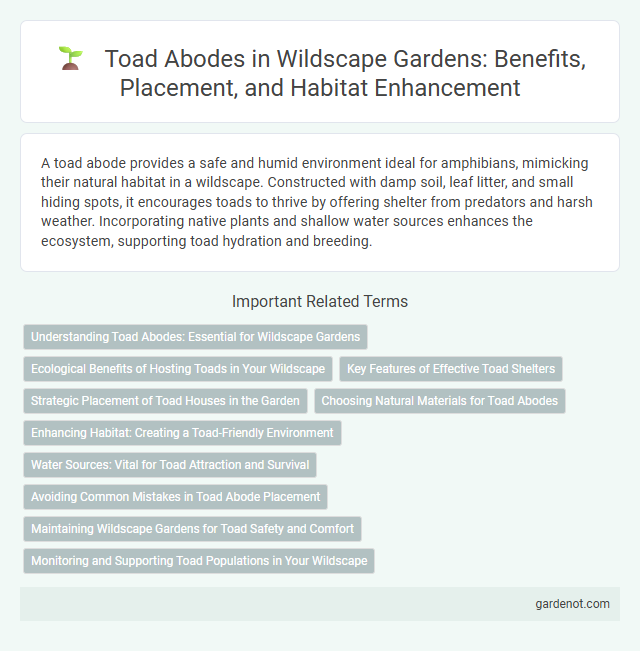A toad abode provides a safe and humid environment ideal for amphibians, mimicking their natural habitat in a wildscape. Constructed with damp soil, leaf litter, and small hiding spots, it encourages toads to thrive by offering shelter from predators and harsh weather. Incorporating native plants and shallow water sources enhances the ecosystem, supporting toad hydration and breeding.
Understanding Toad Abodes: Essential for Wildscape Gardens
Toad abodes provide vital shelter and breeding grounds for native toads, enhancing biodiversity in Wildscape gardens. Creating these habitats with natural materials like logs, leaves, and soil mimics their natural environment, promoting toad population stability. Integrating toad abodes supports pest control by encouraging amphibian presence, which reduces insect impact on garden ecosystems.
Ecological Benefits of Hosting Toads in Your Wildscape
Toad abodes in wildscapes provide crucial habitats that support local biodiversity by offering shelter and breeding grounds for toads, which are natural pest controllers feeding on mosquitoes and harmful insects. These amphibians contribute to ecological balance by reducing the need for chemical pesticides, enhancing soil health through their burrowing activities, and serving as bioindicators for environmental quality. Supporting toads in your wildscape promotes a sustainable ecosystem that benefits plants, wildlife, and human well-being.
Key Features of Effective Toad Shelters
Effective toad shelters in Wildscape feature durable, moisture-retentive materials like natural wood or stone that mimic their natural habitat. The shelter must provide ample protection from predators, maintain stable humidity levels, and offer easy access to nearby food sources such as insects. Proper placement in shaded, damp areas ensures toads remain safe and comfortable, promoting healthy population growth within the ecosystem.
Strategic Placement of Toad Houses in the Garden
Strategic placement of toad houses in a garden enhances amphibian shelter and pest control by situating them near moist, shaded areas and native vegetation, creating an ideal habitat for toads. Positioning toad abodes close to water sources like ponds or damp soil supports their breeding and hydration needs. Incorporating these shelters within diverse plant clusters boosts biodiversity and encourages natural pest management through increased toad activity.
Choosing Natural Materials for Toad Abodes
Choosing natural materials like untreated wood, leaves, and moss for toad abodes ensures a safe, non-toxic environment that mimics their natural habitat. These materials retain moisture and provide insulation, critical for toad hydration and temperature regulation. Incorporating local soil and small stones further enhances the abode's authenticity and encourages toad habitation.
Enhancing Habitat: Creating a Toad-Friendly Environment
Designing a toad-friendly habitat involves incorporating damp, shaded areas with ample leaf litter and logs for shelter and moisture retention. Providing shallow water features supports breeding and hydration essential to toad life cycles. Native plants and natural ground cover foster abundant insect populations, ensuring a steady food supply for the toad community.
Water Sources: Vital for Toad Attraction and Survival
Water sources such as ponds, shallow pools, and damp areas are essential for creating an ideal toad abode, as they provide hydration and breeding grounds critical for toad survival. Incorporating natural water features with gradual slopes and vegetation improves water retention and offers shelter, attracting diverse toad species. Proper water quality and consistency prevent habitat loss and support the ecological balance of amphibian populations in wildscapes.
Avoiding Common Mistakes in Toad Abode Placement
Proper placement of a toad abode is crucial for attracting and supporting local amphibians; avoid locations exposed to direct sunlight or heavy foot traffic as these can cause overheating and stress. Position the abode near natural water sources and in moist, shaded areas with ample leaf litter to simulate the toad's natural habitat. Ensuring the entrance is unobstructed and the shelter is secure from predators helps increase occupancy and survival rates.
Maintaining Wildscape Gardens for Toad Safety and Comfort
Maintaining Wildscape gardens for toad safety and comfort involves planting native vegetation that provides ample cover and moisture retention, essential for toad hydration and shelter. Creating shallow water features and leaf litter zones mimics natural habitats, encouraging breeding and protection from predators. Regular removal of pesticides and chemical fertilizers ensures a toxin-free environment that supports healthy toad populations.
Monitoring and Supporting Toad Populations in Your Wildscape
Creating a dedicated toad abode in your wildscape provides essential shelter and breeding grounds that support local toad populations. Regularly monitoring the toad abode helps track population health and detect environmental changes, ensuring timely conservation actions. Implementing supportive measures such as maintaining moisture levels and minimizing pesticides enhances the habitat's suitability for sustaining thriving toad communities.
Toad abode Infographic

 gardenot.com
gardenot.com